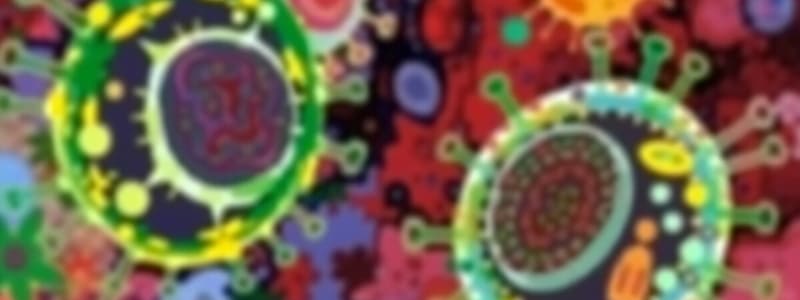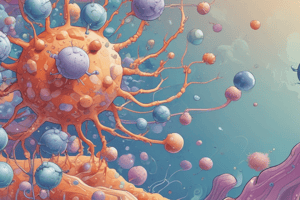Podcast
Questions and Answers
What is the difference between T-dependent and T-independent antibody production?
What is the difference between T-dependent and T-independent antibody production?
T-dependent antibody production requires help from T cells, whereas T-independent antibody production does not.
What is the process of T cell help for B cell antibody production?
What is the process of T cell help for B cell antibody production?
The process involves interactions between activated T helper cells and B cells, leading to B cell proliferation and differentiation into plasma cells.
What is isotype switching?
What is isotype switching?
Isotype switching is the process by which a B cell changes the isotype of antibody it produces without altering its specificity for the antigen.
What is affinity maturation?
What is affinity maturation?
What is the function of Activation-Induced Deaminase (AID)?
What is the function of Activation-Induced Deaminase (AID)?
What are plasma cells?
What are plasma cells?
Which type of B cells secretes IgM antibodies without requiring prior antigenic stimulation?
Which type of B cells secretes IgM antibodies without requiring prior antigenic stimulation?
Follicular B cells are the most common type of antibody-producing lymphocytes in circulation.
Follicular B cells are the most common type of antibody-producing lymphocytes in circulation.
What is necessary for the full activation of B cells producing different antibody isotypes?
What is necessary for the full activation of B cells producing different antibody isotypes?
What are the effector mechanisms of cytotoxic T cells?
What are the effector mechanisms of cytotoxic T cells?
Which cells recognize antigens on class I MHC?
Which cells recognize antigens on class I MHC?
CTLs are the major killers of virus-infected cells and cancer cells.
CTLs are the major killers of virus-infected cells and cancer cells.
The activation of naïve CTL requires Class I and Class II antigen presentation on the same ______.
The activation of naïve CTL requires Class I and Class II antigen presentation on the same ______.
What is the role of perforin in CTL function?
What is the role of perforin in CTL function?
What method do CTLs use to induce apoptosis in target cells?
What method do CTLs use to induce apoptosis in target cells?
What characterizes regulatory T cells (TREGs)?
What characterizes regulatory T cells (TREGs)?
Which cytokines do TREG cells produce?
Which cytokines do TREG cells produce?
Memory T cells require significant co-stimulation to function.
Memory T cells require significant co-stimulation to function.
What growth factor stimulates the proliferation of antigen-activated T cells?
What growth factor stimulates the proliferation of antigen-activated T cells?
Match the following T cell characteristics with their definitions:
Match the following T cell characteristics with their definitions:
Flashcards are hidden until you start studying
Study Notes
### B Cell Subsets
- B-1 cells are self-renewing and found in the peritoneum and mucosa
- Marginal zone B cells are found in the spleen and lymph nodes
- Follicular B cells are the most common type of antibody-producing cell
Stages of Antigen-Specific B Cell Development
- Antibody response to protein antigens takes 3-7 days after antigen exposure
- Naïve B cells with IgM and IgD receptors encounter antigen within secondary lymphoid organs
- Lymph node B and T cells are located in distinct zones - B cell zones and T cell zones.
- The lymphoid follicle is the B cell zone.
- Germinal centers (GCs) are found within follicles and contain actively proliferating B cells and a periphery containing non-proliferating B cells.
- Primary follicles lack GCs and are composed of rapidly dividing plasmablasts actively producing antibody.
Antigen Presentation to B Cells
- Naïve B cells circulate via the blood and lymph until they encounter antigen
- Follicular dendritic cells (FDCs) capture opsonized antigens and present them to follicular B cells
- Macrophages transport antigens from the lymph to follicular B cells
- Differentiation from naïve to effector cells requires co-stimulatory signals from PRRs, TFH cells, or both
- For full B cell activation to occur, these additional factors are needed:
- Help from T helper cells
- CD40-CD40L interactions
Antibody Production by B Lymphocytes to T-dependent Antigens
- For a protein antigen to stimulate an antibody response, B lymphocytes and TH cells must come together in lymphoid organs and interact.
- This interaction stimulates B cell proliferation and differentiation into antibody-producing cells.
Function and Properties of Cytotoxic T Cells
- Cytotoxic T cells (CTLs) recognize antigens presented by class I MHC, and are mainly responsible for killing virus-infected cells and cancer cells.
- CTLs are a major source of pro-inflammatory cytokine, mostly IFNγ.
Activation of Cytotoxic CD8+ T Cells
CTLs are activated from naïve cells to effector cells by acquiring target cell antigens through cross-presentation by antigen presenting cells (APCs).
- Cross-presentation requires both class I and class II antigen presentation on the same APC to activate TH1 and CTLs at the same time.
CTL Killing by Exocytosis of Cytotoxic Granules
- CTLs contain lytic granules containing cytotoxic proteins granzyme and perforin.
- When a CTL interacts with a target cell, a synapse is formed between them.
- Perforin creates pores in the target cell membrane allowing granzyme to enter.
- Granzyme activates caspases to induce apoptosis in the target cell.
- The CTL detaches itself from the target cell and can kill multiple targets.
Intrinsic and Extrinsic Pathways of Apoptosis
- Apoptosis, or programmed cell death, can be initiated by intrinsic or extrinsic pathways.
- The intrinsic pathway involves the release of cytochrome C from the mitochondria, leading to the activation of caspases that initiate the caspase cascade.
- Granzyme and perforin released by CTLs trigger the intrinsic pathway.
- CTLs can also induce apoptosis through the extrinsic pathway by expressing Fas-L, TNFα, and LTβ, which bind to their receptors (Fas, TNFR-I, and TNFR-II) on target cells.
Memory Cells
- Memory cells don’t require antigen exposure to survive, and are long-lived compared to naïve or effector cells.
- Memory cells respond more rapidly to antigen stimulation than naïve cells, and are more numerous than naïve cells specific to the same antigen.
- Memory cells migrate to peripheral tissues, like the skin, and respond to antigen exposure at these sites.
- Memory cells require less co-stimulation than naïve cells to function.
- Maintenance of memory cells is dependent on cytokines (IL-7) and not on repeated antigen exposure.
Regulatory T Cells (TREGs)
- TREGs express the transcription factor FoxP3, which directs expression of high levels of CD25 (IL-2R), and anti-inflammatory cytokines IL-10 and TGF-β.
- TGF-β and IL-10 suppress activation of T, B, and NK cells and hinder APCs from stimulating T cells.
- Their main function is to maintain peripheral tolerance.
- TREGs express high levels of the negative co-stimulator CTLA-4, which competes with CD86(B7) on APC for binding to CD28 on T cells.
- TREGs are mainly generated by self-antigen recognition in the thymus, and by self- and foreign antigen recognition in peripheral lymphoid organs.
- They express high levels of the receptor for the T cell growth factor IL-2.
Interleukin 2 (IL-2) T cell Growth Factor
- IL-2 stimulates the proliferation and differentiation of antigen-activated T cells (clonal expansion).
- It promotes survival of T cells by upregulating expression of Bcl-2, an anti-apoptotic protein.
- IL-2 acts in an autocrine and paracrine manner.
- It stimulates the production of effector cytokines like IFNγ and IL-4 by T cells.
- IL-2 is important for the survival and function of TREG cells.
Studying That Suits You
Use AI to generate personalized quizzes and flashcards to suit your learning preferences.




